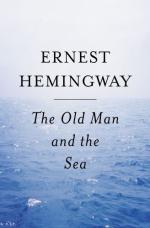|
This section contains 317 words (approx. 1 page at 400 words per page) |

|
The Old Man and the Sea employs straightforward prose and conventional narrative form and technique. Technically speaking, it is perhaps Hemingway's most conventional fiction. None of the modernist techniques — indirection, implication, allusion, omission, unexplained juxtaposition — that Hemingway so elaborately deploys in In Our Time (1925; see separate entry) and other works are used in this parablelike tale, which helps to explain why it reaches the widest audience of any Hemingway work.
Consider, for example, his use of symbolism to suggest that Santiago is a Christ-figure or, at the very least, that Santiago's suffering is analogous to Christ's suffering. After the sharks attack his marlin, Santiago cries out "Ay"; then Hemingway writes that "there is no translation for this word and perhaps it is just a noise such as a man might make, involuntarily, feeling the nail go through his hands and into the wood." The many Christological...
|
This section contains 317 words (approx. 1 page at 400 words per page) |

|




